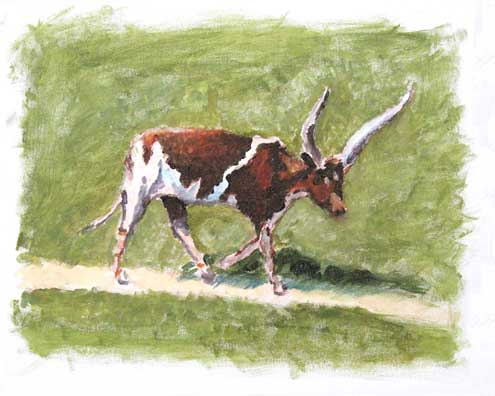Watusi Cow

A somewhat impressionistic rendering of a Watusi cow. That lives in Virginia.
Yes, Virginia, USA. That shouldn't surprise anyone. After all, there are more tigers in Texas than in live in the wild.
Strictly speaking, this cow is an Ankole-Watusi. Not only does this particular individual live in Virginia, you'll find a number of references and popular informational websites which state the Ankole-Watusi breed is actually  and first developed in the 19th century.
and first developed in the 19th century.
With all due respect for those of patriotic sentiments, the most scholarly references tell of a more convoluted intermixing of breeds that goes back to the days of Ancient Egypt and the Sudan and that the cows that are now dubbed Ankole-Watusi were indeed present in Ancient Africa. In fact, given the ubiquity of cattle in the continent's history, it's almost impossible to see how the Ankole-Watusi would arise anywhere else.
The agreement, though, is that Ankole-Watusi were a variety of the Sanga cattle. The Sanga in turn were a mixed breed which arose when the Zebu cattle, originally from what is now Pakistan, reached Africa and interbred with indigenous cattle. This was around 2000 B. C. The mixing of the genes of the Zebu, with large shoulder humps and prominent dewlaps, with the longer horned but humpless and flapless African breeds produced cows with a continuum of humps, flaps, and horns.
But it was the cows around Lake Victoria - in the areas of modern Uganda and Rwanda that became most notable. Raised by the ancestors of the modern Tutsi tribe and their neighbors, the animals developed monstrous but surprisingly light-weight horns. The horns were not only formidable weapons - the cows could fight lions - but they had an internal honey-comb like construction threaded with blood vessels. The horns then acted as a most efficient cooling system which produced a breed well adapted for the sweltering tropical climate. It is in this region that we should probably ascribe the origin of the Ankole-Watusi, and to this day you'll see such cows being raised there.
As we said, though, there are those who ascribe the Ankole-Watusi to American ingenuity and Yankee know-how. However to think the interbreeding of cattle breeds that were present for millennia in a single region of Africa would be postponed until after the mid-1800's America is a bit of a stretch. Not to say that American cattle breeders didn't continue tinkering until the American Ankole-Watusi may not be completely identical to their African cousins. A casual look does indicate the America herds tend to have a bit more spottled coats with more white on the undersides than those in Africa. But as anyone who looks at the cattle (or people) can see, the individual variations within a group are greater than any supposed difference between the averages of the population. But what the Americans particularly noticed was that having such impressive looking cows was something people would pay good money for.
All the more ironic is that the Ankole-Watusi may be going extinct in Africa. That's because other breeds of cattle - particularly the Holstein - are better dairy cows and the culture in Africa is to use cows for milk and dairy products rather than meat. In fact, the Masaai, who live in Kenya and Tanzania, are known for keeping large cattle herds and yet eat virtually no meat from their cows As Holsteins can produce 20 to 30 times the milk of the Ankole-Watusi, they are being raised more and more in Africa as well as in other countries.
Fortunately there are now people dedicated to the survival of the impressive Ankole-Watusi bovines both in Africa and in other countries. To this end there are organizations and registries throughout the world. So Ankole-Watusi fans have no cause for despair!
References
The Complete Cow , Sara Rath, Voyageur Press, 1998, 2017.
"All About Ankole Watusi Cattle: Breed Spotlight - Watusi Cattle, the Cattle of African Kings", Klaire Bruce, Countryside Magazine, February 15, 2018.
"Breeds of Livestock - Ankole-Watusi Cattle", Breeds of Livestock, Department of Animal Science, Oklahoma State University.
World Watusi Association, www.watusi.org.
"A Dying Breed", Andrew Rice, The New York Times Magazine, January 27, 2008.